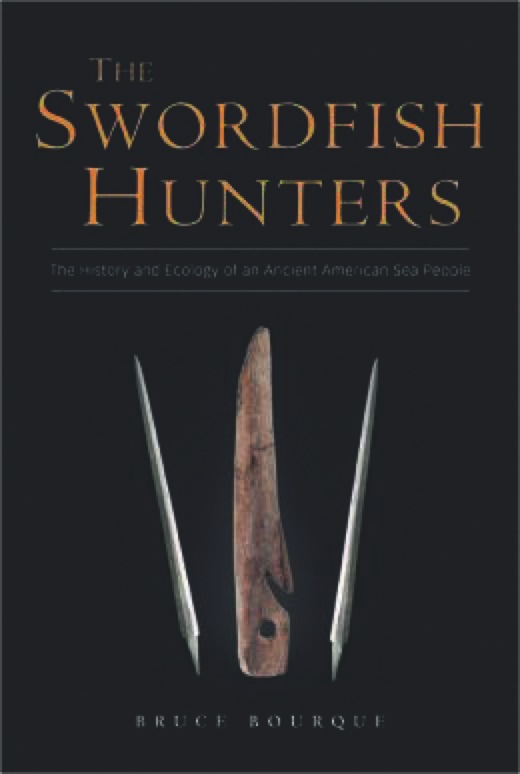Bruce Bourque is a lucky man.
Doubtless, his job as curator of archeology at the Maine State Museum is a rewarding one, as must be his position as senior lecturer in anthropology at Bates College. But above all, he is one of those fortunate people who early on become fascinated by a particular conundrum and are then able to devote their career to unraveling its mysteries.
In “The Swordfish Hunters: The History and Ecology of an American Sea People,” Bourque’s story is interwoven with the broader narrative of current trends in archeological practice and the specific tale of the enigma of the “swordfish hunters.”
Young Bourque came along at just the right time. A confused series of archeological assumptions about these hunter-gatherers — also known as the Red Paint People — had been hanging fire since the 1920s. Interest, which started in 1700 with the discovery of some beautiful lance-heads by the governor of then French Quebec, had run dry. American archeologists were following their passions to “more exotic foreign regions.”
For 50 years, the Red Paint People remained “mysterious, poorly understood, and clearly unlike other prehistoric cultures in the region.” When interest in Northeastern prehistory began to revive in the late 1960s, Bourque was there, ready to penetrate their secrets.
Archeology comes in all kinds of guises. The first “dig” was among the various collections, both professional and amateur, spread over the Northeast; the French colonial governor’s collection is in an Ursuline convent in Trois Rivieres, Quebec.
At the same time, Bourque was scouring Maine’s coast for new sites, specifically burial sites covered with the red ocher that gave the culture its name. His big break came on North Haven island, where he arrived by accident, having missed the ferry to Vinalhaven. It was “a lucky one that shaped my field research for the next two decades.”
In his book, Bourque pieces together the Red Paint People’s story with the meticulousness, if not quite the flair, of an Agatha Christie. In the process, his perspective widens beyond the traditional limits of his profession and into the realms of marine ecology. At the North Haven site, he and his excavating team found an abundance of codfish bones so large that at first, they didn’t recognize them.
This led Bourque to participate in a national study of “the deep history of marine ecosystems” and the changes that even prehistoric humans wrought on the marine food web. The “ancient faunal remains” — through their size, abundance and chemistry — are vastly reconfiguring the scale of what has been lost. Discovering this “fishing down of marine food webs” was “a transforming experience — nothing less than a personal paradigm shift.”
By the end of “The Swordfish Hunters,” Bourque has pinned down a compelling argument for a complex culture that developed and disappeared in less than 1,000 years some 4,000 years ago. Located between the lower reaches of the Androscoggin and St. John rivers, they traded by sea over large distances.
Although they could (and did) catch cod more easily and safely, their special prey was the swordfish. Bourque explains this “economically irrational” behavior as “costly signaling,” where the benefits to the tribe of competent leadership outweigh economic efficiency. The headmen were the boat captains whose mettle was tested by successfully challenging a dangerous animal on the open sea.
Swordfish hunting is only one aspect that intrigues Bourque. He also suggests that the Red Paint People may have had a ritual trading relationship with cultures to their north. The beautiful ground slate objects that first attracted attention were cut and smoothed far away from the cemeteries where they were found.
And just as Bourque cites other swordfishing cultures around the world in comparison with the Red Paint People, he compares this hypothesis with the Kula ring of Papua New Guinea, another maritime culture where objects acquire ritual value far in excess of their economic worth.
At the beginning of his book, Bourque makes a handsome promise to keep archeological jargon to a minimum. In this, he is largely successful. Every now and then, one is rewarded by a sentence as bracing in its construction as its meaning. Summing up a comparison of the rate of biological and cultural adaptation, he writes: “Cultures change their minds, not their genes.”
However, in matters mechanical, I found my comprehension taxed — as, for instance, in the need for foreshafts, or how a toggling harpoon works. Fortunately, the book is beautifully illustrated with color plates of all these artifacts.
They are quite enough to make one understand the author’s wonder at these “flamboyant” but mysterious people. It is a fascinating saga.
Thomas Urquhart is a former director of Maine Audubon and author of “For the Beauty of the Earth.”
Send questions/comments to the editors.



Success. Please wait for the page to reload. If the page does not reload within 5 seconds, please refresh the page.
Enter your email and password to access comments.
Hi, to comment on stories you must . This profile is in addition to your subscription and website login.
Already have a commenting profile? .
Invalid username/password.
Please check your email to confirm and complete your registration.
Only subscribers are eligible to post comments. Please subscribe or login first for digital access. Here’s why.
Use the form below to reset your password. When you've submitted your account email, we will send an email with a reset code.